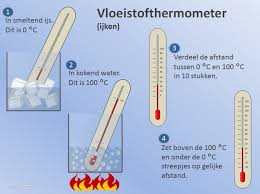If you can blow glass you can also create an analogue thermometer: a small reservoir with on top a thin tube partially filled with mercury or alcohol and sealed, so the air pressure does not affect the fluid level. When it gets warmer (the fluid expands) it rises, when it’s cold it drops.
 The advantage of mercury is that the thermal expansion coefficient is almost constant over a broad temperature range. The mercury is clearly readable, and does not stick to the glass wall. Mercury freezes at -38.9°C and boils at 356.9°C.
The advantage of mercury is that the thermal expansion coefficient is almost constant over a broad temperature range. The mercury is clearly readable, and does not stick to the glass wall. Mercury freezes at -38.9°C and boils at 356.9°C.
A heat scale was defined in 1742 by the Swedish astronomer Anders Celsius to 100 degrees as the temperature of melting ice and 0 degrees as the temperature of boiling water. His successor Stromer turned the numbers around the scale as we still use them today.
Crickets give fairly accurate in temperature. If it is warmer they tweet faster (about 62 tweet per minute at 13°C, each species has its own rate). The relationship between the temperature and the rate of chirping is known as Dolbear 's Law.
In the snowy tree cricket (Oecanthus fultoni) you get the temperature in Fahrenheit by adding 40 to the number of tweetings in 14 seconds. There are several formulas (and several crickets) in circulation. For degrees Celsius you count the chirps in 8 seconds and add 5. (Or chirps per 25 sec / 3, and then +4.)
Like every meteorologist they are sometimes a bit off, but never more than 2°C. For Dutch and Flemish crickets, no data are known.
'Cold! If the thermometer was a few inches taller, we were all frozen to death!“ (Mark Twain)
“It does not matter how hot or cold it is in the room, it's always room temperature.”(Steven Wright)
